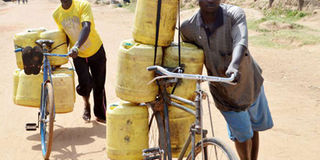Clean water now a reality in Busia

Residents of Funyula, Busia County, fetch water at Sio Port Channel on February 10, 2017. PHOTO | KEVIN ODIT | NATION MEDIA GROUP
What you need to know:
- Ojaamong is targeting to supply 65 per cent of Busia residents with clean, reliable and affordable water by year's end.
Before the advent of devolution, residents of Busia County could only tell bad tales when it came to water supply.
Walking for long distances, dirty river water and constant diarrhoea all defined their quest to access potable water.
The most affected areas were Samia and Budalang’i constituencies, which ironically border the world’s third largest water mass – Lake Victoria.
Locals had to walk long distances in search of water with the most affected being women and children.
Five years into devolution, the situation has greatly improved.
The Busia County government has drilled over 100 solar-powered boreholes, one of the flagship projects rolled out by Governor Sospeter Ojaamong in 2014.
DRAINAGE
Governor Ojaamong told the Nation that the project has changed lives by improving water supply in all the seven sub-counties.
“Our water is clean and safe for drinking and in the near future Busia residents might not see the need to buy bottled water.
"It is in our target that in 2018 our people will not walk more than half a kilometre to get water.
"We also intend to extend piped water systems in rural and urban areas and also develop the sewerage systems in all our major towns,” he said.
The governor added that the county is targeting to supply 65 per cent of Busia residents with clean, reliable and affordable water by the end of this year.
“Before the introduction of solar-powered boreholes, the 100 boreholes’ water pumps were running on the main national electricity grid or (were) manually initiated. This was an economical blow due to high electricity bills but now things have changed,” Mr Ojaamong said, adding that about Sh30 million was being spent on bills yearly.
The solar project has seen over 50 per cent of locals access clean and affordable water.




